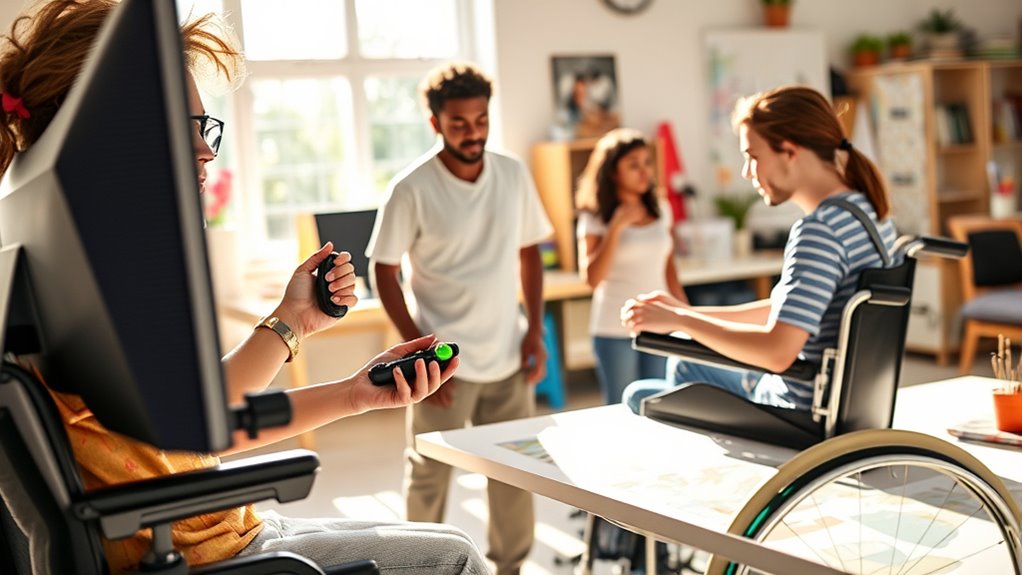Adaptive tools and techniques help everyone engage more easily with technology and their surroundings. Whether it’s voice recognition, alternative input devices, or digital adjustments like high-contrast visuals, these solutions remove barriers and foster independence. They support diverse needs, making tasks more manageable and communication smoother. By using inclusive design principles, you create environments that welcome all abilities. Keep exploring to find out how these tools can truly transform everyday experiences for everyone involved.
Key Takeaways
- Adaptive tools like screen readers, voice recognition, and mobility aids enable users with diverse needs to perform tasks independently.
- Inclusive design ensures digital and physical environments are accessible through adjustable features, clear labels, and high-contrast visuals.
- Assistive technologies support communication, navigation, and daily activities, fostering greater participation for all abilities.
- Combining assistive tools with inclusive design creates more user-friendly, flexible environments that accommodate diverse physical and cognitive needs.
- Ongoing innovations in adaptive technology improve accessibility, promoting equity, independence, and seamless integration for users worldwide.

Adaptive tools and techniques have become essential in helping individuals and organizations overcome challenges and improve efficiency. When you embrace assistive technology and inclusive design, you open the door to more accessible environments that support people of all abilities. These innovations aren’t just for those with disabilities—they benefit everyone by creating more flexible and user-friendly spaces and systems. By integrating adaptive tools, you guarantee that tasks are more manageable, and communication flows seamlessly, regardless of individual differences.
Assistive technology plays a critical role in this process. It includes devices like screen readers, voice recognition software, alternative keyboards, and mobility aids that empower users to perform tasks they might otherwise find difficult or impossible. When you implement these tools, you’re not only removing barriers but also fostering independence. For example, a person with visual impairments can navigate digital content effortlessly with screen magnifiers or text-to-speech programs. Similarly, someone with motor challenges can utilize adaptive switches or ergonomic input devices to interact with computers more comfortably. These tools adapt to the user’s needs, making daily activities more accessible and less frustrating. Understanding the history of pinball machines highlights how technological innovations can transform entertainment and accessibility over time.
Assistive devices empower users to perform tasks easily, fostering independence and making daily activities more accessible.
Inclusive design complements assistive technology by making sure that products, environments, and systems are inherently accessible from the start. When you prioritize inclusive design, you’re creating solutions that consider the diverse needs of all users. This approach involves designing interfaces that are easy to understand, operate, and navigate, regardless of physical or cognitive abilities. It encourages the development of websites, apps, and workplaces that are intuitive and welcoming. For example, using clear labels, adjustable font sizes, and high-contrast visuals makes digital content accessible for everyone. Incorporating inclusive design principles means you’re not retrofitting solutions later but building accessibility into the foundation of your projects.
Together, assistive technology and inclusive design foster a culture of accessibility that benefits everyone. When you adopt these strategies, you not only comply with legal standards but also demonstrate empathy and understanding. This approach leads to increased participation, productivity, and satisfaction for users and employees alike. Whether you’re designing a new workspace, developing software, or modifying existing tools, considering adaptive tools and techniques assures that you’re creating environments that truly serve all individuals. Ultimately, embracing these principles helps you build a more equitable and inclusive society where everyone has the opportunity to succeed and thrive.
Frequently Asked Questions
How Do Adaptive Tools Improve Daily Independence?
Adaptive tools improve your daily independence by providing assistive technology tailored to your needs. These tools make tasks easier, allowing you to accomplish activities on your own and boosting your confidence. With assistive technology, you can manage daily routines more effectively, promoting independence enhancement. Whether it’s voice-activated devices or specialized equipment, these tools support your abilities, helping you live more independently and participate actively in everyday life.
What Funding Options Are Available for Adaptive Technology?
You can access various funding sources and financial assistance options for adaptive technology. These include government programs like Medicaid and Medicare, grants from non-profit organizations, and assistance through insurance policies. Some local community resources and vocational rehabilitation services also offer support. To find the best options, you should research eligibility criteria and application processes. Securing funding can help you afford essential adaptive tools, enhancing your independence and daily functioning.
Can Adaptive Tools Be Customized for Individual Needs?
Like a tailor fitting a suit to your shape, adaptive tools can be customized for your needs. You have numerous personalization options to guarantee they suit your specific requirements. However, customization challenges exist, such as technical limitations or costs. Despite these hurdles, manufacturers often develop adaptable solutions, allowing you to modify tools for ideal comfort and functionality—making technology truly work for you.
How Do I Choose the Right Adaptive Tool for Someone?
You choose the right adaptive tool by evaluating the individual’s specific needs and preferences. Consider options with assistive communication features and ergonomic design to guarantee comfort and effectiveness. Observe how they interact with different tools, involve them in the decision-making process, and consult specialists if needed. Prioritize ease of use, durability, and compatibility with existing devices, ensuring the selected tool genuinely supports their daily activities and promotes independence.
Are Adaptive Tools Suitable for All Age Groups?
Yes, adaptive tools are suitable for all age groups. By focusing on universal design principles, you can guarantee these tools promote age inclusivity, making them accessible and effective for children, adults, and seniors alike. You should consider the specific needs and abilities of each age group, selecting adaptive tools that support independence and engagement across different stages of life. This approach helps create inclusive environments for everyone.
Conclusion
By embracing adaptive tools and techniques, you can create inclusive environments that support everyone’s abilities. Did you know that 15% of the world’s population has some form of disability? Incorporating these strategies not only empowers individuals but also enhances overall productivity and engagement. When you adapt your approach, you’re fostering a more equitable space where all abilities are recognized and valued. Remember, small adjustments can make a big difference in transforming lives.










